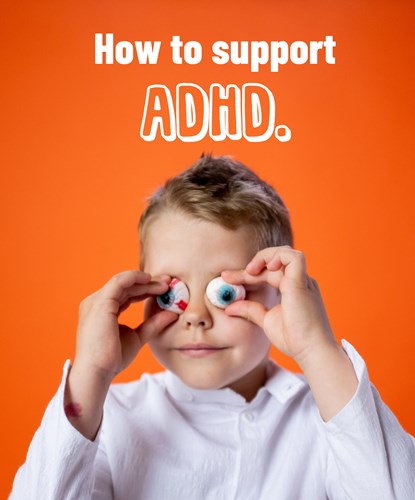Supporting Children with ADHD
Attention Deficit Hyperactivity Disorder (ADHD) is a neurological / neurodevelopmental disorder that impacts a child (or adult’s) ability to pay attention and control impulses. ADHD is not a result of poor parenting or a case of a child “just being naughty”.
There can be co-occurring conditions with ADHD such as anxiety, oppositional behaviour and learning difficulties, just to name a few. While ADHD will present differently in individuals, most children with ADHD have poor sustained attention, poor impulse control, are distractible, constant, and very active. In children, ADHD can result in difficulties sitting still, paying attention, thinking before they act, and doing what they are asked.

Many children with ADHD are creative, inventive, energetic, enthusiastic, and/or can think laterally. It can be helpful to help children with ADHD to find what they are best at.
A comprehensive approach to working with children with ADHD includes communicating with other family members, schools, and professionals who are involved in your child’s care and treatment.
Typical parenting or school strategies often need to be adapted for children with ADHD as the usual parenting strategies such as reasoning with your child or ignoring difficult behaviour can often increase ADHD behaviours.
Some helpful adaptations include:
- Only giving single instructions. Over time it may be possible to increase to more than one instruction at a time, but children with ADHD need to learn to cope with following one instruction at a time first.
- Use a firm, steady voice (monotonous, not emotional).
- Slow down your speech.
- Be brief. Don’t reason with your child (this can easily turn into a debate or argument). Children with ADHD don’t know why they behave the way they do, so it is not helpful to ask them why they behave in certain ways.
- Communicate simply and clearly (children with ADHD often have language and auditory processing problems).
- Act quickly. Don’t ignore the child’s behaviour.
- Have firm boundaries and structure in place and be consistent. Discuss the rules and boundaries with your child so that they are aware and have them somewhere visible so that you and your child can refer back to them. Remind your child of the rules when they begin to break them.
- Be prepared to be repetitive, with a consistent message.
- Don’t get into a debate or a lecture. Simply remind the child of the rules and choices (e.g. that if they choose to do X behaviour, they choose Y consequence).
- Rather than yelling instructions from another room, speak directly to your child to help them to pay attention, listen, and understand.
- Develop weekly routines.
- Remove “I” or “You” statements. This can be seen as rejection or ignoring their feelings. Instead, show that they have choices with their behaviour, for example, if the child says, “You made me cranky”, you might say, “No, you chose to yell and hit out. You chose to go to time out”.
- Don’t use the word “maybe”. Be clear and firm. Children with ADHD interpret “maybe” as agreeing to what they want.
- Limit choices. Too many choices can be overwhelming or anxiety provoking.
- Rewards and consequences for behaviour should be immediate.
- Rewards need to be worthwhile to the child – they can become easily bored with the same rewards.
- Stay calm and on track – don’t give in.
- Balance the positive and the negative. Ensure that you give praise for appropriate behaviour. Look for opportunities to praise your child for appropriate behaviour.
Expect to make mistakes, it is a normal part of the process.
Our clinicians at The Hummingbird Centre are skilled and experienced in assisting people to assist with ADHD behaviours and parenting
